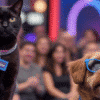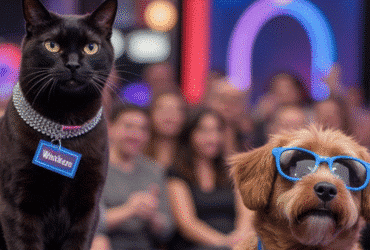
Winter Pet Apparel and Footwear
Hi everyone, and thanks for joining me on this episode of Val Talk’s Pets! Here we are at the end of February, and in many climates, there is still a […]
 play_arrow
play_arrowDog and Cat Trivia Challenge 1.3 Val Cairney

 play_arrow
play_arrow🐾 Cat & Dog Trivia 102 Val Cairney

Hi everyone, and thanks for joining me on this episode of Val Talk’s Pets. Today’s episode is the next installment of trivia with Cats and Dogs Trivia 102.
So get those thinking caps on and keep score if you like, as we hit the quiz for cats and dogs.
To begin, have you heard the words, omnivore, carnivore, obligate, thrown around? What do these words mean?
First, let’s define them, and then we will see how you assign them to a dog and a cat.
An omnivore, as defined by Oxford Languages, is “an animal that eats food of both plant and animal origin.” An omnivore eats meat, too, as opposed to a herbivore that eats only plant material.
A carnivore, according to Merriam Webster, “is an animal that feeds mainly or only on meat, or a plant that traps and digests insects.”
Now an obligate carnivore as defined by Wikipedia, “is one whose diet requires nutrients found only in animal flesh. While obligate carnivores might be able to ingest small amounts of plant matter, they lack the necessary physiology required to fully digest it.”
Is a dog an omnivore, a carnivore, an obligate carnivore or none of the above?
The answer is none of the above, but if you said carnivore, you are the closest, so give yourself a point.
A dog is a facultative carnivore. According to Dogster.com, “This means that they need an animal protein-based diet, but they can benefit from eating plants too.” As Dogster explains, there is an enzyme that breaks down starch and other foods besides meat. In humans, this is found in the saliva. In a dog, it is in the stomach, so this makes it less effective because it takes a longer time for the food to come into contact with Amylase (Am uh laz), the enzyme to break down the matter. “Research suggests that dogs developed the ability to digest grains due to interacting with humans, and this was a major step in their domestication.”
You may often hear people talk about feeding their dog a more ancestral diet. This is the idea that dogs were meant to eat meat in its raw form, and the addition of grains is not indigenous to a dog’s digestion. Now, as stated, dogs have evolved to be able to digest grains, but as also stated, not in the most efficient way. This is where a pet parent has to decide on the type of food they wish for their dog.
So, final answer…a dog is a facultative carnivore.
The answer is, a cat is an obligate carnivore.
If you have heard a cat being described as a true carnivore, this is the same thing.
Cats are made to thrive on a meat-only diet. To get all the nutrients their bodies need, they must eat meat; in other words, they are obligated to eat meat.
So the question arises, why are there grains in many cat food formulas? Well, according to justcatlover.com, “grains are not necessary for your cat’s diet, but they are not harmful either. They offer essential nutrients, energy, aid digestion, help maintain weight and support overall feline health.”
I’m not all that convinced. If my cat is a true carnivore, then I don’t see the need for grains, and my Rory is turning 15 next month and shows no signs of slowing down. I must be doing something right.
So cats? Obligate or true carnivores.
What do you think is the real ratio of human years to dog years?
Is it a certain number of years, period, or does it fluctuate with age? Is one year of a human’s life equivalent to 7 years of a dog’s life? True or False?
The answer is false.
Here is the basic chart for dog years:
Now, the idea is to also realize that breed and size can factor into these numbers, but generally speaking, dogs grow more rapidly in their first few years. So, no, the 7 years to every human year does not apply.
I think many believe that it is 5 years for every 1 human year. Is this your thought, too?
The answer is, no, it’s not.
Here is the chart for cat years:
That makes my Rory, 76 years old in human years. Well at 76 he still can run like the wind, jump on a counter and play with his toys and explore the world like he’s never seen it before. I should be so lucky.
Answer: Yes, they do. But as usual, there is more to it than that.
According to petmd.com, “At the most basic level, a wagging tail simply means the dog is responding to something in their environment. They are trying to convey how they are feeling about what is happening, and that can help people understand what kind of interaction the dog is attempting to have.”
Two factors are important in interpreting a dog’s tail communication:
Tail position and speed.
So, think of the tail as their voice. The faster they wag, the louder the voice. As PetMD explains, the base of the tail and its position will convey the mood. Is the dog scared, excited, concerned, curious, happy or angry?
The speed of the wag will indicate the intensity of that mood or emotion.
I like the idea of thinking that the position is the mood and the degree of the wag is the voice of that mood. That’s why it is never good to assume a dog is friendly just because it is wagging its tail. The tail could be quite erect and wagging fast which can indicate aggression.
So yes, dogs do wag their tails when they are happy, but the tail communicates so much more, and it is our job to learn that language.
If by wagging we mean lashing it back and forth, the answer is yes, they are ticked off. But, just like dogs, a cat’s tail can tell a story as well.
According to catster.com, there are a few signs of communication we get from a cat’s tail:
The answer is yes, they both do during REM sleep.
Most pet parents have watched their dog in deep sleep, and they are twitching, or even slightly barking or whimpering. Cats twitch too, and some even howl.
According to saatva.com, we can’t definitively know what a dog is dreaming, but it is probably things like their daily life, playing or walking. Or they could be thinking back to instincts where they are hunting. They could be recalling a positive or a negative experience that is playing out in their mind. These stress-related situations can easily bring on distressing dreams.
Cats will dream too during REM sleep, twitching or even chattering. They may be dreaming about hunting or exploring. They dream about you or the other animals in the household. And they, too, can dream about stressors that could bring out a fear or stress that comes out in their dreaming.
The answer is no.
It is important not to startle a dog or cat out of a bad dream, as they may be disoriented and could act aggressively. Also, in order for the pet to be in the dream state, they must achieve REM sleep. REM sleep is important for their well-being, and jerking them out of REM sleep breaks the process of this much-needed sleep.
The pet will usually sleep and process through the bad dream and wake up on their own.
This is where you come in.
If you are present during the nightmare, wait it out, monitor your pet, and when they wake up, offer them comfort and safety.
The answer is yes, they do.
The primary reason for a dog staring at you in a relaxed way is to express their affection for you. According to AKC.org when a dog stares at you in a relaxed way, oxytocin is released and this is considered the love hormone.
Other reasons that your dog may be staring at you include judging your body language. When a dog stares at its human, it may be looking for body language cues that may mean something is coming that benefits them. Are treats coming? Is it time for a walk? Any chance of play time?
Your dog is looking for any signals, hence staring at you.
But, the best and most frequent reason is that your dog is communicating to you that they trust and love you.
The answer is, yes, they do!
According to Brook Farm Veterinary Center, cats stare to communicate. If the cat is relaxed and content, it is probably communicating its affection for you. Cats are also very curious, so they may be staring at you to see what you might do, or stare at you when you are sleeping because your sounds and movements are interesting.
As well, a cat may be staring at you to practice their hunting skills. Observing and assessing you like they would prey, helps keep their skills honed. That’s a bit disturbing.
The best one however, is when a cat is staring at you and they slowly blink at you. This behaviour is known as a cat kiss.
According to Catster.com, an extra slow and relaxed blink shows a sign of trust and affection. And you can reciprocate by slowing blinking back, communicating your mutual affection for each other.
Your kitty will understand this and appreciate you using their language to say I love you.
Well, there you have it. How did you do? It’s always fun to test our pet knowledge. We either confirm that we know a fair bit or find some areas where we can increase our knowledge.
I hope you had fun with this pet trivia quiz, and you can always check out Pet Trivia 101 if you haven’t already.
Because, as I say, knowing is caring. 🐾

Tagged as: Pet Quiz, cat trivia, dog trivia, pet trivia, Fun Pet Facts, Pet Knowledge.
Hi everyone, and welcome to Val Talk’s Pets, the forum for pet parents and enthusiasts alike. So, I have been working in the pet industry now for almost 10 years and, on a daily basis, I handle a lot of issues and questions arising from pet parents. I am not a veterinarian but I do have certifications in Canine, Feline, Small Animal, Fish and Herptile and Avian Health and Nutrition from the University of California, Davis Extension, the Vet College.

Val Cairney February 28, 2025
Hi everyone, and thanks for joining me on this episode of Val Talk’s Pets! Here we are at the end of February, and in many climates, there is still a […]

Val Cairney October 3, 2025

Val Cairney September 19, 2025
For the price of a coffee, or more if you are feeling generous, you can help keep this podcast going & growing. Please visit my ko-fi page to make a donation. Thanks!
all rights reserved - Val Talks Pets - 2024